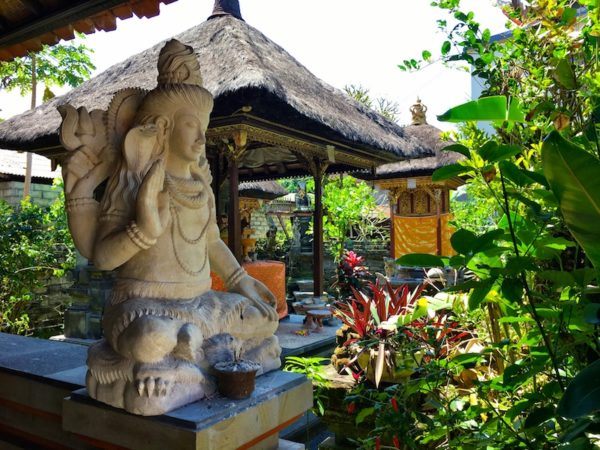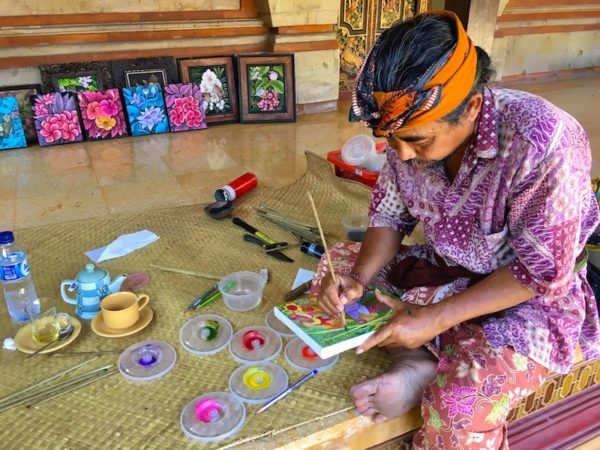This post was originally published in 2017. It has since been updated for accuracy of links and content.

A painter I am not. But I didn’t let that stop me from taking a Balinese painting class with a local (and well-known) artist in Ubud.
A painter I am not. (This bears repeating). Of the four artistic modalities, I excel at the other three (drama, music, dancing). But the visual arts has always escaped me. I’m simply unable to conjure up something from the depths of my imagination and visually bring it to life. Growing up, I envied doodlers. I couldn’t even do that.
A few years ago I explained this to some friends of mine in Australia.
“Nonsense!” They said, and whipped out some play dough. “Make something – whatever comes to mind. Let your creative genius shine.” they said.
As we all sat there with our chunks of play dough, I focused on my blob. I wanted to allow the sculpture within my blob to shine. So I moulded my blob into another blob. Twenty minutes later I presented my creation.
My friends had been busy making little flowers, and people, and balls and squares. Their eyes widened when they saw my blob. Too embarrassed to admit that I was right (I’m a talentless hack when it comes to visual arts), they said “well….it’s….it….it just needs a little….” and proceeded to try to make my blob into something that was at least somewhat aesthetically appealing. Not long after they gave up, and we never spoke of it again.
So why on earth would I take a Balinese painting class, you might ask?
Yeah. Well, two reasons.
Ubud is the artistic and cultural centre of Bali, and as such, I wanted to immerse myself in all that Ubud has to offer. Tourism to Bali actually started back in the 1930’s when a string of famous artists and performers started arriving. People such as Walter Spies, Willem Hofker, Rudolf Bonner, Charlie Chaplin, Noel Coward, Barbara Hutton, H.G. Wells, Vicki Baum, and Arie Smit all helped to define Bali as a place of artistic pursuit. Given this long-standing history of Bali inspiring great artists, I thought Bali could inspire me too.
Secondly, you may recall from my experience visiting Tsukiji Fish Market in Tokyo that I’m a fan of using local tour guides. So when I arrived in Bali, I browsed the many experiences I could do on Withlocals, and for some inexplicable reason, this Balinese painting class jumped out at me.
I’ve long known about Withlocals, and I was delighted when they agreed to offer me a couple of tours for free. Although I appreciated the savings, the truth is it’s negligible – these kinds of tours with local folk are generally very inexpensive to begin with. This half-day Balinese painting class, for example, costs 30 Euros and includes all the supplies to produce (and keep) my own painting, as well as lunch.
My Balinese Painting Teacher

Putu could not have been a more genial and supportive teacher. As an icebreaker, I asked him some questions about his family compound, where we were seated.
“How many children do you have?”
“Five, but my last child is the most special to me,” he replied. This surprised me; most parents don’t express such blatant favouritism. When I enquired further, he delved into a long story of how his last son (who is four years old, and was born to he and his wife long after you’d surmise their child-bearing years had ended) was actually a reincarnation of his father, who had died very shorty before their conception. I was enraptured, and by the end I was a believer too, as we watched his son laugh and run around the compound like he built the place (as Putu’s father had done).
We discussed how earning a living as an artist in Bali has changed over the years. Putu is less busy creating art to sell to tourists and locals (something that was big business in the 80’s and 90’s), and much busier creating art and carvings and sculptures for local religious ceremonies of all kinds.
For Putu, art is a way of life, not a modality. When he needs to paint, he paints. When he needs to carve, he carves. And when he needs to pick flowers or plant rice, he does that. To him, everything is art.
Somehow in relating all of this, he made me feel much better about my own ability – or lack thereof – to be artistic. He made me feel like the very act of breathing was art.

Balinese Painting – Philosophy
What attracted me to this Balinese painting class was the idea that there is an entire philosophy behind the act, and I wanted to learn more about it.
Watch the video to see Putu describe the four stages of creating art in the Balinese way, but here they are in short:
- The Sketch: speaking with your compass. Outlining your sketch is like chatting with your friends. And when you speak in this fashion, you’re figuring out what you mean to say as you talk. It’s kind of like talking shit with your friends. (Putu didn’t say it this way, obviously….but I’m pretty sure that’s what he meant).
- The Lines: clarify what you’re saying. While the sketch might be full of fuzzy pencil lines as your idea takes shape, now is the time to make sure you really know what you’re saying. Using charcoal dissolved in water and a pointy bamboo pencil-brush, it’s time to commit and draw some real lines. (This stage was terrifying for me; apparently I prefer just talking shit).
- Shading: what’s important? The shading process is your chance to make your thought three-dimensional, and to highlight the points you really want to drive home.
- Colour: personality, details. Colouring in your creation adds your own personal flair, and further fills in the details.
- (Bonus Stage): Fixing it. This stage involves getting Putu to add some touches to make my painting look like something I don’t immediately want to burn.

Balinese Painting (Vlog Ep. 22)
Meet Putu in this fun video, and watch me create a not-so-wretched piece of art in the Balinese painting tradition!
Click here to watch this on YouTube
Related Posts and Videos
Touring Tsukiji Fish Market with a Local



Hi Nora,
Loved seeing you on video; I dig the touch. Beautiful background too.
Bali is one of my fave places on earth. Definitely not because I am an arteeest – a painter, I am not, too – but because of the people, the culture, the natural beauty and the overall feel of the place.
These people are in this world, but not of this world. They are heavily focused on the spirit world as a way of life.
I recall those temple offerings every 3-5 hours or so around the clock, and seeing the endless ceremonies as a token of gratitude for papayas, cell phones, motorbikes, heck, anything.
What a loving, warm, heart felt people, the Balinese.
Also cool to hear how his last child is his fave, being the reincarnation of his dad. These folks are dialed into a very real world that most of us here in the West ignore, or explain away as being nonsense, or, not real.
Thanks for sharing Nora.
Ryan
Hey Ryan,
Thanks! You’re so right about the Balinese people being in a very different headspace from much of the rest of the world, and quite focused on the spirit world. I’m going to publish a post about the ceremonial offerings (Canang Sari) very soon!
Love it, Nora! I watched your video and thanks for sharing. What a great story, too. The Balinese are such a sweet people in my experience and I really enjoyed watching Putu. I look forward to seeing other creative classes you take on your travels 🙂
Hey Suzette,
Isn’t Putu awesome?!? 🙂 Glad you enjoyed vicariously taking my class with me!
I remember that post from Tsukiji! Been meaning to use withlocals for quite a while now. This was a great suggestion. To experience Balinese painting is so unique and I loved “meeting” Putu from your story. Definitely a true artist!
Putu rocked! And I was so happy how his personality shone through on the video as well. That smile!